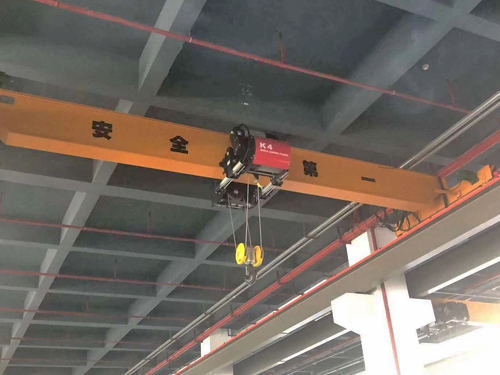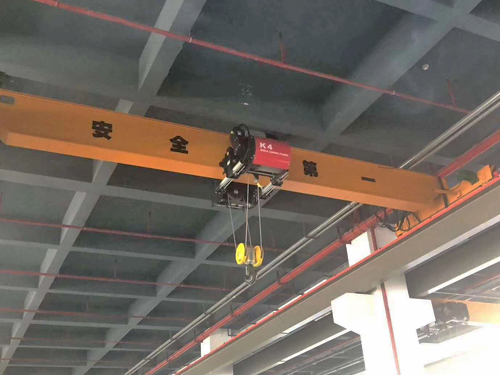- Sitemap
- Online consultation

Scan WeChat

Scan WeChat
About Us
- Service Hotline -+86-135-2866-9221

Crane is characterized by intermittent movement, that is, the corresponding mechanisms of reclaiming, transporting, unloading and other actions in a working cycle work alternately. Each mechanism is often in the working state of starting, braking and running in forward and reverse directions. Cranes can be divided into:
Overhead Crane:
Because its two ends sit on the supports of tall concrete columns or metal track beams, it is shaped like a bridge (overpass). The bridge of the bridge crane (travel crane) runs longitudinally along the tracks laid on the elevated on both sides, which can make full use of the space under the bridge to lift materials without being hindered by ground equipment. It is the most widely used and the largest number of cranes, and it is also the most used large-scale equipment for lifting heavy objects in the workshop. The bridge frame of the bridge crane runs longitudinally along the tracks laid on the elevated bridges on both sides, and the hoisting trolley runs laterally along the tracks laid on the bridge frame, forming a rectangular working range, which can make full use of the space under the bridge frame to lift materials without Obstructed by ground equipment. This kind of crane is widely used in indoor and outdoor warehouses, factories, docks and open storage yards. Overhead crane (travel crane) is an important tool and equipment to realize mechanization and automation of production process in modern industrial production and lifting and transportation. Therefore, bridge cranes are widely used in indoor and outdoor industrial and mining enterprises, iron and steel chemical industry, railway transportation, port terminals and logistics turnover departments and places.
Gantry crane:
Gantry crane is a variant of bridge crane. It is mainly used for the loading and unloading of outdoor cargo yards, stockyards and bulk cargoes. Its metal structure is like a door-shaped frame, and two feet are installed under the bearing main beam, which can walk directly on the track on the ground, and the two ends of the main beam can have outrigger cantilevers. Gantry cranes (gantry cranes) have the characteristics of high site utilization, large operating range, wide adaptability and strong versatility, and are widely used in port cargo yards. A gantry crane is simply a crane like a door frame with outriggers. Classification hook gantry crane, grab gantry crane, electromagnetic gantry crane, grab hook gantry crane, grab electromagnetic gantry crane, three-purpose gantry crane. The main function is that it is used more outdoors, or the workshop does not have the ability to install bridge cranes. Generally, gantry cranes are used. It is mostly used for installation, loading and unloading, or for shipbuilding and power stations.

Tower Cranes:
Tower cranes are referred to as tower cranes, also known as tower cranes, which originated in Western Europe. According to records, the first patent for a tower crane for construction was issued in 1900. In 1905, a crane with a fixed jib appeared in the tower body. In 1923, a prototype of a modern tower crane was made. In the same year, the first relatively complete modern tower crane appeared. In 1930, Germany had begun mass production of tower cranes and used them for construction. In 1941, the German industrial standard DIN8770 for tower cranes was published. The standard stipulates that the lifting capacity of the tower crane is represented by the heavy moment together with the product (tm) of the lifting load (t) and the amplitude (m).
A slewing crane with its boom mounted on top of a tall tower. It has a large working space and is mainly used for the vertical and horizontal transportation of materials and the installation of building components in the construction of houses. It consists of three parts: metal structure, working mechanism and electrical system. The metal structure includes tower body, boom and base, etc. The working mechanism has four parts: lifting, luffing, turning and walking. The electrical system includes motors, controllers, power distribution cabinets, connecting lines, signals and lighting devices.
From the perspective of the technical development of tower cranes, although new products emerge one after another, and the new products have improved in terms of production efficiency, simple operation, easy maintenance and reliable operation, the technology of tower cranes has not fundamentally changed. The research of tower crane is developing towards combination. The so-called combined type is to take the tower body structure as the core, decompose the tower body into several parts according to the structural and functional characteristics, and divide each part into several modules according to the requirements of serialization and generalization, following the principle of the modular system. According to the parameter requirements, appropriate modules are selected to form tower cranes with different technical performance characteristics to meet the specific needs of construction. The implementation of combined tower cranes will help speed up the development of tower crane products, save product development costs, and better serve customers.
About us
Company ProfileBusiness philosophyManufacturing processCaseVideoOur TeamHonorProducts
Single Girder Overhead...Double girder overhead...Jib CraneGantry CraneCrane AccessoriesQD bridge craneElectric flat carNews
Company newsCrane knowledgeIndustry informationContact us
ContactFeedbackNetworkSales TeamPledgesQuick Contact
 Cell phone station
Cell phone station Manager WeChat
Manager WeChatDongguan Huarui Crane Co.,Ltd. Copyright © 2022 All rights reserved Technical Support :Dongguan website construction 【Admin】【Baidu Statistics】【Gmap】【Back to top】
Service Hotline
Miss Yuan
Mobile

Back to top